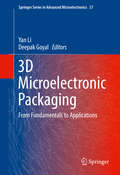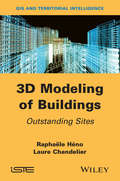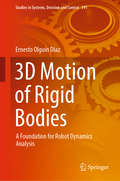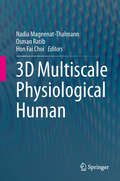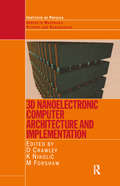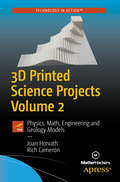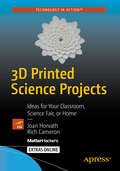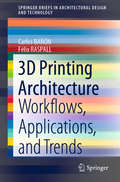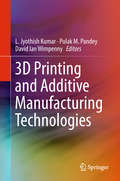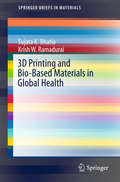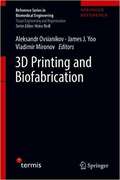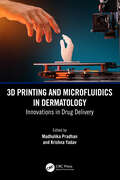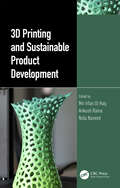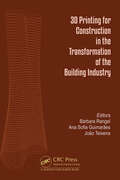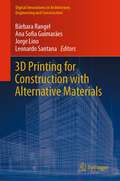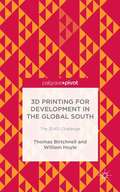- Table View
- List View
3D Microelectronic Packaging: From Fundamentals to Applications (Springer Series in Advanced Microelectronics #57)
by Yan Li Deepak GoyalThis volume provides a comprehensive reference for graduate students and professionals in both academia and industry on the fundamentals, processing details, and applications of 3D microelectronic packaging, an industry trend for future microelectronic packages. Chapters written by experts cover the most recent research results and industry progress in the following areas: TSV, die processing, micro bumps, direct bonding, thermal compression bonding, advanced materials, heat dissipation, thermal management, thermal mechanical modeling, quality, reliability, fault isolation, and failure analysis of 3D microelectronic packages. Numerous images, tables, and didactic schematics are included throughout. This essential volume equips readers with an in-depth understanding of all aspects of 3D packaging, including packaging architecture, processing, thermal mechanical and moisture related reliability concerns, common failures, developing areas, and future challenges, providing insights into key areas for future research and development.
3D Modeling of Buildings: Outstanding Sites
by Raphaële Héno Laure ChandelierConventional topographic databases, obtained by capture on aerial or spatial images provide a simplified 3D modeling of our urban environment, answering the needs of numerous applications (development, risk prevention, mobility management, etc.). However, when we have to represent and analyze more complex sites (monuments, civil engineering works, archeological sites, etc.), these models no longer suffice and other acquisition and processing means have to be implemented. This book focuses on the study of adapted lifting means for “notable buildings”. The methods tackled in this book cover lasergrammetry and the current techniques of dense correlation based on images using conventional photogrammetry.
3D Modeling of Nonlinear Wave Phenomena on Shallow Water Surfaces
by I. B. AbbasovWith climate change, erosion, and human encroachment on coastal environments growing all over the world, it is increasingly important to protect populations and environments close to the sea from storms, tsunamis, and other events that can be not just costly to property but deadly. This book is one step in bringing the science of protection from these events forward, the most in-depth study of its kind ever published. The analytic and numerical modeling problems of nonlinear wave activities in shallow water are analyzed in this work. Using the author’s unique method described herein, the equations of shallow water are solved, and asymmetries that cannot be described by the Stokes theory are solved. Based on analytical expressions, the impacts of dispersion effects to wave profiles transformation are taken into account. The 3D models of the distribution and refraction of nonlinear surface gravity wave at the various coast formations are introduced, as well. The work covers the problems of numerical simulation of the run-up of nonlinear surface gravity waves in shallow water, transformation of the surface waves for the 1D case, and models for the refraction of numerical modeling of the run-up of nonlinear surface gravity waves at beach approach of various slopes. 2D and 3D modeling of nonlinear surface gravity waves are based on Navier-Stokes equations. In 2D modeling the influence of the bottom of the coastal zone on flooding of the coastal zone during storm surges was investigated. Various stages of the run-up of nonlinear surface gravity waves are introduced and analyzed. The 3D modeling process of the run-up is tested for the coast protection work of the slope type construction. Useful for students and veteran engineers and scientists alike, this is the only book covering these important issues facing anyone working with coastal models and ocean, coastal, and civil engineering in this area.
3D Motion of Rigid Bodies: A Foundation for Robot Dynamics Analysis (Studies in Systems, Decision and Control #191)
by Ernesto Olguín DíazThis book offers an excellent complementary text for an advanced course on the modelling and dynamic analysis of multi-body mechanical systems, and provides readers an in-depth understanding of the modelling and control of robots. While the Lagrangian formulation is well suited to multi-body systems, its physical meaning becomes paradoxically complicated for single rigid bodies. Yet the most advanced numerical methods rely on the physics of these single rigid bodies, whose dynamic is then given among multiple formulations by the set of the Newton–Euler equations in any of their multiple expression forms. This book presents a range of simple tools to express in succinct form the dynamic equation for the motion of a single rigid body, either free motion (6-dimension), such as that of any free space navigation robot or constrained motion (less than 6-dimension), such as that of ground or surface vehicles. In the process, the book also explains the equivalences of (and differences between) the different formulations.
3D Multiscale Physiological Human
by Nadia Magnenat-Thalmann Osman Ratib Hon Fai Choi3D Multiscale Physiological Human aims to promote scientific exchange by bringing together overviews and examples of recent scientific and technological advancements across a wide range of research disciplines. As a result, the variety in methodologies and knowledge paradigms are contrasted, revealing potential gaps and opportunities for integration. Chapters have been contributed by selected authors in the relevant domains of tissue engineering, medical image acquisition and processing, visualization, modeling, computer aided diagnosis and knowledge management. The multi-scale and multi-disciplinary research aspects of articulations in humans are highlighted, with a particular emphasis on medical diagnosis and treatment of musculoskeletal diseases and related disorders. The need for multi-scale modalities and multi-disciplinary research is an emerging paradigm in the search for a better biological and medical understanding of the human musculoskeletal system. This is particularly motivated by the increasing socio-economic burden of disability and musculoskeletal diseases, especially in the increasing population of elderly people. Human movement is generated through a complex web of interactions between embedded physiological systems on different spatiotemporal scales, ranging from the molecular to the organ level. Much research is dedicated to the understanding of each of these systems, using methods and modalities tailored for each scale. Nevertheless, combining knowledge from different perspectives opens new venues of scientific thinking and stimulates innovation. Integration of this mosaic of multifaceted data across multiple scales and modalities requires further exploration of methods in simulations and visualization to obtain a comprehensive synthesis. However, this integrative approach cannot be achieved without a broad appreciation for the multiple research disciplines involved.
3D Nanoelectronic Computer Architecture and Implementation (Series in Material Science and Engineering)
by David Crawley K. Nikolic M. ForshawIt is becoming increasingly clear that the two-dimensional layout of devices on computer chips hinders the development of high-performance computer systems. Three-dimensional structures will be needed to provide the performance required to implement computationally intensive tasks. 3-D Nanoelectronic Computer Architecture and Implementation reviews the state of the art in nanoelectronic device design and fabrication and discusses the architectural aspects of 3-D designs, including the possible use of molecular wiring and carbon nanotube interconnections. This is a valuable reference for those involved in the design and development of nanoelectronic devices and technology.
3D Printed Conducting Polymers: Fundamentals, Advances, and Challenges (Smart 3D/4D Printing)
by Ram K. GuptaConducting polymers are smart materials that possess unique and tuneable electrical, optical, and electrochemical properties. 3D printing technology is rapidly advancing, and using conducting polymers for this process can lead to many emerging applications as it can print complex structures cost effectively, though many challenges need to be overcome before this technology can be used on a large scale. 3D Printed Conducting Polymers highlights the state of the art of these materials, the basics of additive printing, and the role of conducting polymers in additive manufacturing. It also discusses applications in energy, sensors, and biomedical areas. Covers fundamentals, synthesis, and various applications of conducting polymers. Discusses basics of energy devices, sensors, and materials technology for emerging applications. Explores new approaches for the synthesis of conducting polymers and composites for 3D print technology. Details future applications and challenges. Offering direction to researchers and advanced students to better understand the chemistry and electrochemical properties of conducting polymers and technologies for 3D printing, this book advances the science and technology of this emerging field for readers in materials and chemical engineering, biotechnology, energy, and related disciplines.
3D Printed Science Projects Volume 2: Physics, Math, Engineering and Geology Models
by Joan Horvath Rich CameronLearn physics, engineering, and geology concepts usually seen in high school and college in an easy, accessible style. This second volume addresses these topics for advanced science fair participants or those who just like reading about and understanding science. 3D Printed Science Project Volume 2 describes eight open-source 3D printable models, as well as creative activities using the resulting 3D printed pieces. The files are designed to print as easily as possible, and the authors give tips for printing them on open source printers. As 3D printers become more and more common and affordable, hobbyists, teachers, parents, and students stall out once they've printed some toys and a few household items. To get beyond this, most people benefit from a "starter set" of objects as a beginning point in their explorations, partially just to see what is possible. This book tells you the solid science stories that these models offer, and provides them in open-source repositories. What You Will Learn: Create (and present the science behind) 3D printed models Review innovative ideas for tactile ways to learn concepts in engineering, geology and physics Learn what makes a models easy or hard to 3D print Who This Book Is For: The technology- squeamish teacher and parents who want their kids to learn something from their 3D printer but don't know how, as well as high schoolers and undergraduates.
3D Printed Science Projects: Ideas for your classroom, science fair or home
by Joan Horvath Rich Cameron3D Printed Science Projects describes how to create 3D printable models that can help students from kindergarten through grad school learn math, physics, botany, chemistry, engineering and more. Each of the eight topics is designed to be customized by the reader to create a wide range of projects suitable for science fairs, extra credit, or classroom demonstrations. Science fair project suggestions and extensive "where to learn more" resources are included, too. You will add another dimension to your textbook understanding of science. What you'll learn To create (and present the science behind) 3D printed models. To use a 3D printer to create those models as simply as possible. New science insights from designing 3D models. Who this book is for This book shows parents and teachers how to use the models inside as starting points for 3D printable explorations. Students can start with these models and vary them for their own explorations. Unlike other sets of models that can just be scaled, these models have the science built-in to allow for more insight into the fundamental concepts. Topics covered in this book: 3D Math Functions Light and Other Waves Gravity Airfoils Simple Machines Plants and their Ecosystems Molecules Trusses
3D Printing (Idiot's Guides)
by Cameron Coward3D printing is the hottest new technology. It allows just about any at-home inventor, artist, or engineer to design, create, and "print" their own parts, artwork, or whatever else can be imagined — all at very reasonable costs. Idiot's Guides: 3D Printing explores this new revolution by explaining all of the basics of materials, parts, software, modeling, design, and finishing. The book then takes it to the next level by teaching readers how to take their new skills and print some simple, fun projects. Helpful advice on setting up a home-built 3D printer, buying a manufactured printer, selecting raw materials, and finding plans and projects online, are also covered.
3D Printing (The MIT Press Essential Knowledge Series)
by John M. JordanAn accessible introduction to 3D printing that outlines the additive manufacturing process, industrial and household markets, and emerging uses.The use of 3D printing—digitally controlled additive manufacturing—is growing rapidly. Consumer models of 3D printers allow people to fabricate small plastic objects, from cabinet knobs to wedding cake toppers. Industrial uses are becoming widespread, as businesses use the technology to fabricate prototypes, spare parts, custom-fitted prosthetics, and other plastic or metal items, often at lower cost and with greater efficiency than standard manufacturing. In this volume in the MIT Press Essential Knowledge series, John Jordan offers an accessible introduction to 3D printing, describing the printing process, industrial and household markets, and emerging uses. Jordan outlines the stages of 3D printing, from idea to software model to a printable file that slices the planned object into printable layers to the finished object itself. He describes additive technologies, consumer 3D printing in homes and schools, mass customization (which can create tens of millions of unique items), and industrial uses. Jordan explains that although 3D printers have not become the ubiquitous home appliance once predicted, they are making inroads into mass markets; and he discusses the business factors that may hinder industry adoption of 3D printing technologies. He considers the possible unintended consequences of 3D printing on jobs, as companies scramble to find employees with an uncommon skill set; on business models and supply chains, as manufacturing is decentralized; and on patent law, as machines can be programmed to copy protected property. Finally, Jordan looks at new and emerging uses, including bioprinting, building construction, and micromachines.
3D Printing And Additive Manufacturing: Principles And Applications
by Chee Kai Chua Kah Fai LeongAdditive Manufacturing (AM) technologies are developing impressively and are expected to bring about the next revolution. AM is gradually replacing traditional manufacturing methods in some applications because of its unique properties of customisability and versatility. This book provides a very comprehensive and updated text about different types of AM technologies, their respective advantages, shortcomings and potential applications. 3D Printing and Additive Manufacturing: Principles and Applications is a comprehensive textbook that takes readers inside the world of additive manufacturing. This book introduces the different types of AM technologies, categorised by liquid, solid and powder-based AM systems, the common standards, the trends in the field and many more. Easy to understand, this book is a good introduction to anyone interested in obtaining a better understanding of AM. For people working in the industry, this book will provide information on new methods and practices, as well as recent research and development in the field. For professional readers, this book provides a comprehensive guide to distinguish between the different technologies, and will help them make better decisions regarding which technology they should use. For the general public, this book sheds some light on the fast-moving AM field. In this edition, new AM standards (e.g. Standard of Terminology and Classification of AM systems) and format standards will be included, Furthermore, the listing of new machines and systems, materials, and software; as well as new case studies and applications in industries that have recently adopted AM (such as the Marine and Offshore industry) have also been incorporated.
3D Printing Architecture: Workflows, Applications, and Trends (SpringerBriefs in Architectural Design and Technology)
by Carlos BAÑÓN Félix RASPALLThis book investigates how architectural design advances as a result of the rapid developments in 3D Printing. As this technology become more powerful, faster and cheaper, novel workflows are becoming available and revolutionizing all stages of the design process, from early spatial concepts, to subsequent project development, advanced manufacturing processes, and integration into functional buildings. Based on a literature review and case studies of ten built projects, the book discusses the implications of the ongoing manufacturing revolution for the field of architecture.
3D Printing Projects: Toys, Bots, Tools, and Vehicles To Print Yourself
by James Floyd Kelly John Baichtal John Edgar Park Nick Ernst Caleb Cotter Brian Roe Steven Bolin Brook Drumm Rick WinscotEven if you've never touched a 3D printer, these projects will excite and empower you to learn new skills, extend your current abilities, and awaken your creative impulses. Each project uses a unique combination of electronics, hand assembly techniques, custom 3D-printed parts, and software, while teaching you how to think through and execute your own ideas. Written by the founder of Printrbot, his staff, and veteran DIY authors, this book of projects exemplifies the broad range of highly personalized, limit-pushing project possibilities of 3D printing when combined with affordable electronic components and materials. In Make: 3D Printing Projects, you'll:Print and assemble a modular lamp that's suitable for beginners--and quickly gets you incorporating electronics into 3D-printed structures.Learn about RC vehicles by fabricating--and driving--your own sleek, shiny, and fast Inverted Trike.Model a 1950s-style Raygun Pen through a step-by-step primer on how to augment an existing object through rapid prototyping.Fabricate a fully functional, battery-powered screwdriver, while learning how to tear down and reconstruct your own tools.Get hands-on with animatronics by building your own set of life-like mechanical eyes.Make a Raspberry Pi robot that rides a monorail of string, can turn corners, runs its own web server, streams video, and is remote-controlled from your phone.Build and customize a bubble-blowing robot, flower watering contraption, and a DIY camera gimbal.
3D Printing and Additive Manufacturing Technologies
by David Ian Wimpenny Pulak M. Pandey L. Jyothish KumarThis book presents a selection of papers on advanced technologies for 3D printing and additive manufacturing, and demonstrates how these technologies have changed the face of direct, digital technologies for the rapid production of models, prototypes and patterns. Because of their wide range of applications, 3D printing and additive manufacturing technologies have sparked a powerful new industrial revolution in the field of manufacturing. The evolution of 3D printing and additive manufacturing technologies has changed design, engineering and manufacturing processes across such diverse industries as consumer products, aerospace, medical devices and automotive engineering. This book will help designers, R&D personnel, and practicing engineers grasp the latest developments in the field of 3D Printing and Additive Manufacturing.
3D Printing and Bio-Based Materials in Global Health: An Interventional Approach to the Global Burden of Surgical Disease in Low-and Middle-Income Countries (SpringerBriefs in Materials #First Edition)
by Sujata K. Bhatia Krish W. RamaduraiThis book examines the potential to deploy low-cost, three-dimensional printers known as RepRaps in developing countries to fabricate surgical instruments and medical supplies to combat the “global surgical burden of disease.” <P><P>Approximately two billion people in developing countries around the world lack access to essential surgical services, resulting in the avoidable deaths of millions of individuals each year. A fundamental barrier that inhibits access to surgical care in these locations is the lack of basic surgical instruments and supplies in healthcare facilities. RepRap printers are highly versatile 3D printers assembled from basic, domestically sourced materials that can fabricate low-cost surgical instruments on-site, ultimately enhancing the interventional capacity of healthcare facilities to treat patients. <P><P> Rather than focusing on one specific field of interest, this book takes an integrative approach that incorporates topics and methods from multiple disciplines ranging from global health and development economics to materials science and applied engineering. <P> These topics include the feasibility of using bio-based plastics to fabricate surgical instruments via 3D printing sustainably, the application of "frugal innovation and engineering” in resource-poor settings, and analyses related to the social returns on investment, barriers to entry, and current and future medical device supply-chain paradigms. In taking a multi-disciplinary approach, the reader can gain a holistic understanding of the multiple facets related to implementing medical device innovations in developing countries.
3D Printing and Biofabrication (Tissue Engineering and Regeneration)
by Aleksandr Ovsianikov James Yoo Vladimir MironovProvides an in-depth introduction to 3D printing and biofabrication.<P><P> Covers inkjet, extrusion and laser-based processing of cell-containing materials.<P> Includes mathematical models used in tissue engineering.<P>This volume provides an in-depth introduction to 3D printing and biofabrication and covers the recent advances in additive manufacturing for tissue engineering. The book is divided into two parts, the first part on 3D printing discusses conventional approaches in additive manufacturing aimed at fabrication of structures, which are seeded with cells in a subsequent step. The second part on biofabrication presents processes which integrate living cells into the fabrication process.
3D Printing and Bioprinting for Pharmaceutical and Medical Applications (Emerging Materials and Technologies)
by Jose Luis Pedraz Muñoz Laura Saenz del Burgo Martínez Gustavo Puras Ochoa Jon Zarate SesmaThe increasing availability and decreasing costs of 3D printing and bioprinting technologies are expanding opportunities to meet medical needs. 3D Printing and Bioprinting for Pharmaceutical and Medical Applications discusses emerging approaches related to these game-changer technologies in such areas as drug development, medical devices, and bioreactors. Key Features: Offers an overview of applications, the market, and regulatory analysis Analyzes market research of 3D printing and bioprinting technologies Reviews 3D printing of novel pharmaceutical dosage forms for personalized therapies and for medical devices, as well as the benefits of 3D printing for training purposes Covers 3D bioprinting technology, including the design of polymers and decellularized matrices for bio-inks development, elaboration of 3D models for drug evaluation, and 3D bioprinting for musculoskeletal, cardiovascular, central nervous system, ocular, and skin applications Provides risk-benefit analysis of each application Highlights bioreactors, regulatory aspects, frontiers, and challenges This book serves as an ideal reference for students, researchers, and professionals in materials science, bioengineering, the medical industry, and healthcare.
3D Printing and Bioprinting in Medicine and Surgery: Proceedings of the 4th National Congress of the Italian Digital Biomanufacturing Network, September 26-27, 2024, Florence, Italy (Biosystems & Biorobotics #35)
by Monica Carfagni Simona Celi Michaela Servi Marta MencarelliThis book covers cutting-edge research and developments in additive manufacturing for biomedical engineering. It gathers the proceedings of the Fourth edition of the national congress of the Italian Digital Biomanufacturing Network (IDBN), held on September 26–27, 2024, in Florence, Italy. The eleven peer-reviewed chapters included in this book, report on topics related to 3D printing and bioprinting in medicine and surgery. They cover additive manufacturing techniques applied to medical diagnosis and treatment, as well as innovative procedures for fabrication of medical devices, personalised approaches to patient treatment and patient-specific preoperative planning. They also report on advanced materials and biomaterials with properties suitable for medical and surgical applications. All in all, this book offers a timely snapshot for both researchers and professionals working at the interface between bioengineering and manufacturing.
3D Printing and Microfluidics in Dermatology: Innovations in Drug Delivery
by Madhulika Pradhan Krishna Yadav3D Printing and Microfluidics in Dermatology provides a thorough exploration and applications of three-dimensional (3D) printing and microfluidics within the field of dermatology. It investigates various methods utilized in these fields, such as 3D bioprinting, nano-transporters, microscopic fabrication, and device development.The book not only examines practical applications but also delves into the design principles crucial for implementing these techniques using specific materials tailored to their intended purposes. Additionally, it addresses ethical concerns and regulatory considerations pertinent to these evolving technologies.Key highlights include the following: A detailed insight into the utilization of 3D printing and microfluidic technologies for treating skin disorders. Exploration of design concepts necessary for effective implementation, considering the unique properties of materials involved. Coverage of diverse methodologies, ranging from 3D bioprinting to nano-transporters, microscopic fabrication, and device engineering. In-depth discussion on ethical considerations vital for the sustainable development of the industry. Investigation into advancements in material development, device design, fabrication techniques, and performance evaluation through preclinical and clinical studies. This book targets graduate students and researchers in fields such as 3D printing, dermatology, drug delivery, bioengineering, and pharmaceutical sciences.
3D Printing and Sustainable Product Development
by Ankush Raina Haq, Mir Irfan Ul Nida NaveedThe text focuses on the role and the importance of 3D printing in new product development processes. It covers various aspects such as the 3D printing revolution and Industry 4.0, sustainability and 3D printing, and economics of 3D printing. It discusses important concepts, including 3D printing, rapid prototyping, mechanical and physical properties of 3D printed parts, nanomaterials, and material aspects of 3D printing. Features 1. Presents recent advances such as Industry 4.0, 4D printing, 3D material mechanical characterization, and printing of advanced materials. 2. Highlights the interdisciplinary aspects of 3D printing, particularly in biomedical, and aerospace engineering. 3. Discusses mechanical and physical properties of 3D printed parts, material aspects, and process parameters. 4. Showcases topics such as rapid prototyping, medical equipment design, and biomimetics related to the role of 3D printing in new product development. 5.Covers applications of 3D printing in diverse areas, including automotive, aerospace engineering, medical, and marine industry. It will serve as an ideal reference text for senior undergraduate, graduate students, and researchers in diverse engineering domains, including manufacturing, mechanical, aerospace, automotive, and industrial.
3D Printing and Ubiquitous Manufacturing (SpringerBriefs in Applied Sciences and Technology)
by Tin-Chih Toly ChenThis book provides a thorough overview of the applications of 3D printing technologies to ubiquitous manufacturing (UM). UM itself represents an application of ubiquitous computing in the manufacturing sector, and this book reveals how it offers convenient, on-demand network access to a shared pool of configurable manufacturing resources, including software tools, equipment, and capabilities. Given its scope, the book will be of considerable interest to researchers in the areas of manufacturing, mechanical engineering, operations management, production control, ubiquitous computing, and sensor technologies, as well as practicing managers and engineers.
3D Printing for Construction in the Transformation of the Building Industry
by Ana Sofia Guimarães Bárbara Rangel João TeixeiraAs concrete revolutionised construction in the 20th century, digitalisation is transforming the building industry (BI). Process automation and 3D printing (3DP) are commonplace in the industry and our homes. However, due to BI’s scale and complexity, Additive Manufacturing (AM) is in its native stage. Ongoing scientific research has been providing knowledge that will simplify the integration of 3DCP in the market, exploring its materiality, technologies, and design methodologies. This book provides an overview of the latest research achievements of the design possibilities that 3DP for construction (3DC) can offer in the various fields of construction, particularly architecture and engineering.
3D Printing for Construction with Alternative Materials (Digital Innovations in Architecture, Engineering and Construction)
by Ana Sofia Guimarães Bárbara Rangel Jorge Lino Leonardo SantanaThis book explores the latest achievements and design possibilities that 3D printing for construction (DPC) can offer, the alternative materials to natural aggregates or cement and even the 4th dimension that is already starting in this area. DPC materiality is starting to be explored in architecture as a new design language to reach not only outrageous forms but also to leverage the building process and its performance. Like Corbusier explored the concrete potentiality of concrete to release the façade and the plan, 3DPC is allowing to straighten design freedom with building performance. Industry and Scientific research are offering design professionals possibilities to start a new design movement. New paths are also starting to be tracked to reduce even more this building system footprint, stalking alternatives to Portland cement (PC). Today is already possible to build with the soil from the buildings’ ground. Leftovers from various industries are opening possibilities to decrease the PC and natural aggregates rate in printable mortars. From the industry, salt is becoming a possibility to be used in 3DPC. Sugar can ashes are improving the mortar performance reducing adjuvants. Construction and demolition waste can substitute natural aggregates and even offer new textures and color possibilities. Finally, to close this edition, the latest steps on the use of Phase Change Materials in additive manufacturing are collected to raise awareness to the next step of AM, the 4D printing.
3D Printing for Development in the Global South: The 3D4D Challenge
by Thomas Birtchnell William HoyleWill 3D printers become as commonplace as mobile phones in the megacities or the backwaters of the Global South? Thomas Birtchnell and William Hoyle assess the development potential of this new technique for producing three-dimensional objects, which resembles the way a paper printer produces pages of text. Will 3D printing for development become a key strategy for community action against enduring material poverty? Birtchnell and Hoyle consider this question through a centrepiece case study on the UK charity techfortrade's 3D4D Challenge.
